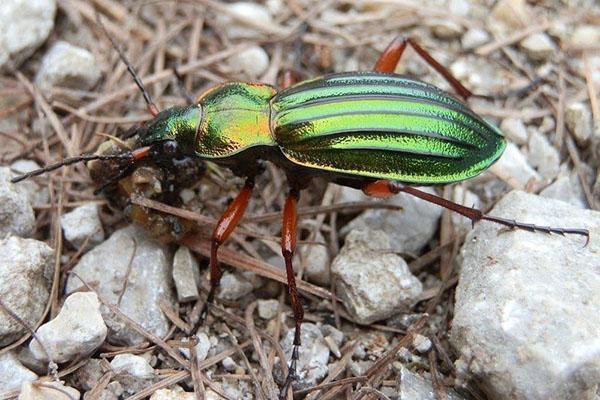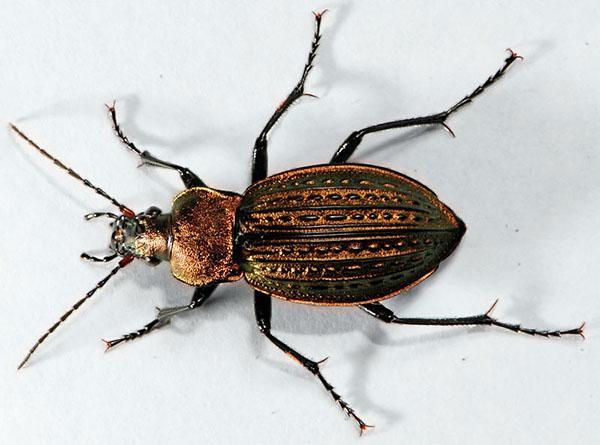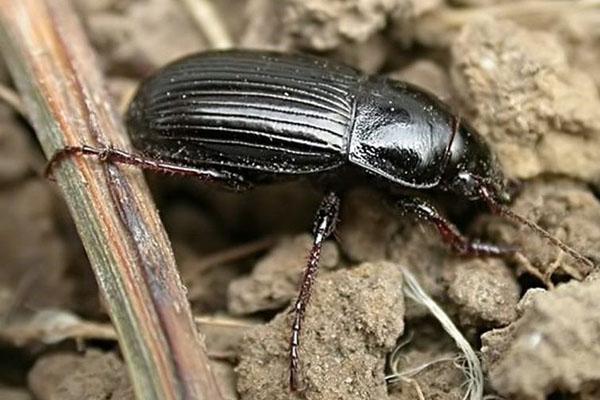Mysterious insect of all time ground beetle

Is it possible to imagine a world without insects, of which there are about 180 thousand species? Many of them are quite attractive, others are ugly, and some, like the ground beetle, deserve special attention. These cute bugs are found on almost all continents, since they exist about 50,000 varieties. Unfortunately, they are not always useful. plants that are grown in gardens or summer cottages. Sometimes you have to fight them using chemicals to save the crop. What does it look like and what does the ground beetle that lives in Europe eat? Answers to these the questions sometimes cause genuine surprise.
External features of an attractive bug

Under the layer of last year's fallen leaves, there are mobile beetles of dark bronze color with the shine of polished silver. They come in a variety of sizes. The length of some barely reaches 3 mm, while other individuals - true "giants" grow up to 30 mm. The ground beetle boasts strong legs that allow it to move quickly in search of food. And powerful jaws remind that she is a dangerous predator.
In the daytime for an insect they serve as a reliable shelter:
- small stones;
- fallen leaves;
- bark of old trees;
- piles of dry rotten grass.

But, as soon as darkness falls on the ground, ground beetles crawl out of their shelter in search of food. They feed not only on vegetation.
Their diet includes:
- all kinds of larvae;
- pupae;
- caterpillars;
- snails;
- slugs.
When the beetle discovers a "delicious meal", it grabs the victim with powerful jaws. He douches it with a specific liquid to begin the digestion process. After that, he begins his meal. This is how the ground beetle destroys garden peststhat cause irreparable harm to plants. Often, after saturation, the bug burrows into the soil for several days. After such a rest, he leaves his hideout to go hunting again.
An adult insect destroys approximately 350 harmful caterpillars per season.
Ground beetle: popular species

On the territory of Europe, there are about 3,000 species of insects from the genus of ground beetles. Each of them has its own unique features:
- "Omophrons" - rounded convex body;
- "Demetrius" - stem-shaped elongated body;
- "Skarits" - the front part of the body is separated from the back, as the beetle leads a burrowing way of life;
- "Horses" - have long thin legs designed for fast movement.

Ground beetles, which are more active during the daytime, have big eyes. In night beetles, they are underdeveloped or completely absent. but many individuals can boast of a gorgeous mustache of an unusual shape.
Most often, in suburban areas, there is an ordinary ground beetle, which is also called garden. The insect has an unusual antennae. The length of its body is about 3 cm. The color is brown or dark graphite. The flaps have small oblong grooves. They are decorated with a golden splash. The garden ground beetle has powerful jaws, since it is considered a predatory insect. Fortunately, her favorite food is garden pests.
Therefore, summer residents try to carefully protect the bug from its natural enemies:
- lizards;
- shrews;
- birds of prey;
- moles.

To promote the growth of ground beetle colonies, it is advisable to intentionally do not kill insects.And instead of pesticides, use substances made from herbs.
Some "explorers" like to pick up various insects. Sensing danger, the ground beetle hits the “enemy” with a specific liquid.
Insect females are able to lay about 80 eggs. A favorite place for masonry is the fertile soil layer, abundant in moisture. Over time, larvae form from them, which eventually become full-fledged beetles. The insect miraculously tolerates winter cold. It hides under sheds, storage rooms or near the foundations of houses. They live small colonies of various types of insects.
Attention - bread beetle

Many gardeners, seeing swift-footed beetles on the plots, consider them to be dangerous pests. Therefore, they are trying in every possible way to fight them, not suspecting that they are destroying their "employees", not enemies. Actually there is only one type of beetle that is harmful to cultural plantings - bread beetle. Unlike her noble relatives, she is colored in black resin color. It grows up to 17 mm. Has short legs, antennae, but a relatively large head. The elytra are convex, decorated with longitudinal lines, what is its distinctive feature.
Adult beetles cause irreparable harm to crops:
- wheat;
- corn;
- barley;
- rye;
- oats.

But what does the ground beetle eat when it “settles” on crops? A favorite delicacy is grain during the ripening period. Damaged crops are unsightly and the ears look like a washcloth. If there are a lot of beetles, bald spots appear on the crops. As a result, a lot of the crop is lost. Interestingly, even ground beetle larvae, which grow up to 3 mm, bring harm to crops. Despite its miniature size, the specimen has an elongated shape. The head is colored resin-brown or brown.
Depending on the diet, the larvae change their color. It happens:
- grayish green;
- cream;
- white.
During the period of active development, they eat barely sprouted grain and plant roots. Pests appear in the fields if cereals are sown there.
To prevent the "settlement" of beetles, you should adhere to the rules:
- do not sow cereals in the same area for 2 years in a row;
- before sowing, treat grain with special substances;
- when ears appear, spray the crops with chemicals;
- harvest in a timely manner;
- plow the soil deeply.
It is interesting that the larvae are in a state for a long time inactivity at a depth of 15 cm from the topsoil. Therefore, agronomists do soil analysis. It is important for ordinary summer residents to know how to deal with ground beetle, during its invasion of culture.
Protecting cereals from a pesky enemy

Since ground beetle larvae live next to food cultures, they feed on them freely. In the dark they crawl out of burrows to feast on young leaves of wheat. In addition they harvest greens for their daily food. Gradually, the larvae can to destroy huge areas of crops of cereals.
An effective protective agent against ground beetles are insecticides that contain active substances:
- chlorpyrifos;
- dimethoate;
- imidoclapride;
- cypermethion.
These components are indicated on the packaging of the drug, which used in the fight against grain ground beetle. Processing is performed at the time of appearance the first shoots of cereal culture. The substance actively affects the root system, seeds and young shoots of the plant.

The insecticide treatment of grain before planting provides complete protection of the plant from the ground beetle.
A noticeable effect can be obtained by spraying cereals that have begun to spike. However, the chemical will act in in the case of a small number of pests on the plantation.
Having got to know the ground beetle better, it became clear that the insect does not always harm the plants.Some species kill garden pests such as caterpillars and slugs. And only the ground beetle causes irreparable harm to cereal crops. By wisely using weapons against her, it is easy to achieve a bountiful harvest.